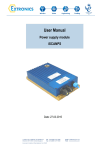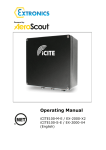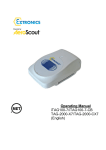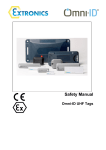Download FM Manual - Extronics
Transcript
FM Safety Manual Omni-ID UHF Tags Operating Manual This page is intentionally left blank. Document Number 334169 (See Last Page for Revision Details) ©2012 Extronics Limited. This document is Copyright Extronics limited. Extronics reserve the right to change this manual and its contents without notice, the latest version applies. 2 Operating Manual Contents 1 2 3 4 5 6 Safety Information and Notes .............................................................................. 4 1.1 Storage of this Manual................................................................................... 4 1.2 List of Notes .................................................................................................. 4 Safety Related Installation Information ................................................................ 6 2.1 Product Marking ............................................................................................ 6 2.2 Temperature Ratings ..................................................................................... 6 2.2.1 Base Station Reader Power Limitation for Temperature Classification ... 7 2.3 Tag Marking and Groups ............................................................................... 8 Structure and Function ...................................................................................... 10 3.1 Intended Purpose Usage ............................................................................. 10 3.2 Transportation and Storage ......................................................................... 10 3.3 Authorized Persons ..................................................................................... 10 3.4 Cleaning and Maintenance .......................................................................... 10 3.5 Safety Precautions ...................................................................................... 10 3.6 Cleaning and Maintenance Intervals ........................................................... 10 3.7 Aggressive substances and environments .................................................. 11 3.8 Exposure to external stresses ..................................................................... 11 FM Certificate - US ............................................................................................ 12 FM Certificate - Canada .................................................................................... 18 Manual Revision ................................................................................................ 24 3 Operating Manual 1 Safety Information and Notes 1.1 Storage of this Manual Keep this user manual safe and in the vicinity of the device. All persons required to work with the device should be advised on where this manual is stored. 1.2 List of Notes The notes supplied in this chapter provide information on the following. Danger! / Warning! o Possible hazard to life or health. Caution o Possible damage to property. Important o Possible damage to enclosure, device or associated equipment. Information o Notes on the optimum use of the device Warning! The RFID tags have been certified as a product range, as such different tag variants will have a different Hazardous (Classified) Location Groups as defined in the NEC and CEC. Additional to this the ambient temperature is dependent upon the tag variant and the RF power it is subjected to from a RFID reader base station. It is impractical to include all this information on the RFID tag label. Therefore the FM certificate and this manual SHALL be used to ascertain the permissible ambient temperatures and T-classes permissible and under which operating conditions the RFID tags can be safely installed and operated. Warning! The user SHALL ensure that if the tags are read in a hazardous area the conducted power into the base station reader antenna, that is the power delivered from the base station transmitter via wires (conducted) to the antenna, is less than that in Table 1 and Table 2 for the relevant product code part (-Z). Any reader antenna gain may be used to provide the maximum EIRP allowed by the country of operation Warning! Only passive antennas may be used to assess the conducted RF power. Warning! When the tags are installed and read by a RFID reader (base station) inside a Hazardous (Classified) Location as defined in the NEC and CEC, the base station used inside the hazardous area must also be certified. Additional to this the base station must be assessed to ensure its RF output power is limited as per Table 1 and Table 2 of this manual Warning! If the tags are damaged in any way they must be removed from the hazardous area. Warning! The user MUST ensure that if the tags are read in a hazardous area the conducted power into the base station reader antenna is less than that in Table 1 and Table 2 for the relevant product code. Conducted power is the RF power delivered from the base station transmitter via wires (conducted) to the antenna The antenna gain can be ignored for FM compliance provided that the antenna 4 Operating Manual gain is passive only, i.e. no electrical amplification between the transmitted output and antenna input or inside the antenna itself. o Warning! The lower ambient temperature for all tag variations is -40 C. Warning! The RFID tags are made from an electrically insulating material and as such are a potential electrostatic hazard if they are installed in an area other than that specified by the FM group on the marking of the tag. Tags marked with X=5 or 6 are permitted ONLY in fixed installations. Under these conditions there may be a potential electrostatic charging hazard. The equipment is not to be mounted in a high airflow dust laden atmosphere and should only be cleaned with a damp cloth. Warning! For (–E, encased), (–M, metal) and (-P, painted) tag variants ONLY, additional to the marked FM code it is permissible for a tag variant to be given the following effective FM marking (note this code will not be marked on the tag for tags with X=1, 2, 3 or 4 but will be marked on tags with X = 5 or 6) : Class I Division 1 Groups A,B,C,D This marking code is FOR FIXED INSTALLATIONS ONLY Under these conditions, there may be a potential electrostatic charging hazard. The equipment is not to be mounted in a high airflow dust laden atmosphere and should only be cleaned with a damp cloth. Warning! -F-L-X tags consist of a label covering a metallic foil which contains Aluminium and is considered to constitute a potential risk of ignition by impact or friction. Care must be taken during installation and use to prevent impact or friction 5 Operating Manual 2 Safety Related Installation Information 2.1 Product Marking The equipment will be marked with the information shown below. Actual layout may vary on each variant: - Omni-ID-Z-Y-X CW10 0HU Class 1 Div 1 Group A,B,C,D Intrinsically Safe Sécurité Intrinsèque Exi T (See Schedule) WARNING – For Fixed Installation Only. Refer to certificate and user manual for conditions of safe use & temperature classification Note: Actual FM Group marking on the tag will vary dependant upon the tag variant. The group marked on the tag must be observed except as specified in section 2.3. The warning label may not be present on the tag. -Z Is used to obtain the ambient temperature and T-class for the tag variant -Y denotes the type of enclosure used (-E for encased plastic, -L for a label tag, -P for a painted tag and –M for a metal tag) -X denotes the size of the electrostatic charging hazard. 2.2 Temperature Ratings The T-class and temperature ratings of the tags will depend on 2 factors. 1. The amount of power conducted in to a reader antenna. That is the power delivered to a radiating antenna from a transmitter. This is NOT the EIRP which also takes into account the antenna gain. 2. The distance between the reader and the tag The RFID tags contain no internal sources of heating; the only thermal rise will be when the tag is under the radiation of an external RFID reader (base station). 6 Operating Manual 2.2.1 Base Station Reader Power Limitation for Temperature Classification Warning! The user MUST ensure that if the tags are read in a hazardous area the conducted power into the base station reader antenna is less than that in Table 1 for Z=R, Table 2 Z=F and Table 3 Z=C. Conducted power is the RF power delivered from the base station transmitter via wires (conducted) to the antenna The antenna gain can be ignored for FM compliance provided that the antenna gain is passive only, i.e. no electrical amplification between the transmitted output and antenna input or inside the antenna itself. Information The antenna gain must be taken in to account when assessing compliance with international radio frequency regulations. Warning! Only passive antennas may be used to assess the conducted RF power. o Tamb ( C) T6 (W) T5 & Group I (W) T4 (W) 40 0.25 0.66 1.5 50 0.18 0.59 1.5 60 0.12 0.53 1.5 70 0.06 0.47 1.5 80 N/A 0.40 1.5 Table 1 – -R variant maximum conducted RF power from RFID base station transmitter output to the reader antenna vs. upper ambient temperature o Tamb ( C) T6 (W) T5 & Group I (W) T4 (W) 40 0.13 0.36 0.79 50 0.10 0.32 0.75 60 0.06 0.29 0.72 70 0.03 0.25 0.68 80 N/A 0.22 0.65 Table 2 – -F variant maximum conducted RF power from RFID base station transmitter output to the reader antenna vs. upper ambient temperature 7 Operating Manual o Tamb ( C) T6 (W) T5 & Group I (W) T4 (W) 40 0.19 0.50 1.10 50 0.14 0.45 1.05 60 0.09 0.40 1.00 70 0.04 0.35 0.95 80 N/A 0.31 0.90 Table 3 – -C variant maximum conducted RF power from RFID base station transmitter output to the reader antenna vs. upper ambient temperature o Warning! 2.3 The lower ambient temperature for all tag variations is -40 C. Tag Marking and Groups All Tags will be marked with –Z-Y-X marking which corresponds to the FM code marking shown in Table 4 and Table 5. Warning! Only install the tags in the area permitted by the FM code marked on the tag. It is only permissible to install the tags in an area permitted by Note 1 if the product code is such that it allows the application of Note 1 AND the tag is installed in a fixed location. Information In this case a fixed installation is defined as an installation where the tag, or the asset the tag is attached to, does not move in normal operation. E.g. if the tag is installed on a hand held tool the tag is not a fixed installation. Z= R R R R R R or or or or or or Y= F F F F F F E E E E E E or or or or or or 1 2 3 4 5 6 Group (Non Fixed Use) A,B,C,D C,D C,D D A,B,C,D C,D C,D D - X= M M M M M M F F F F F L L L L L 1 2 3 4 5 R R R R R L L L L L 1 2 3 4 5 Group (Fixed Use Only) A,B,C,D (Note 1) A,B,C,D (Note 1) A,B,C,D (Note 1) A,B,C,D (Note 1) A,B,C,D (Note 1) A,B,C,D (Note A,B,C,D (Note A,B,C,D (Note A,B,C,D (Note A,B,C,D C,D A,B,C,D (Note C,D A,B,C,D (Note D A,B,C,D (Note A,B,C,D (Note Table 4 – Tag Group markings (1) 8 2) 2) 2) 2) 1) 1) 1) 1) Operating Manual Z= C C C C C C R R R R R R Y= E, E, E, E, E, E, M or M or M or M or M or M or P P P P P P X= P P P P P P 1 2 3 4 5 6 1 2 3 4 5 6 Group (Non Fixed Use) A,B,C,D C,D C,D D A,B,C,D C,D C,D D - Group (Fixed Use Only) A,B,C,D (Note 1) A,B,C,D (Note 1) A,B,C,D (Note 1) A,B,C,D (Note 1) A,B,C,D (Note 1) A,B,C,D (Note 1) A,B,C,D (Note 1) A,B,C,D (Note 1) A,B,C,D (Note 1) A,B,C,D (Note 1) Table 5 – Tag Group markings (2) Note 1! For (–E, encased), (–M, metal) and (-P, painted) tag variants ONLY, additional to the marked FM code it is permissible for a tag variant to be given the following effective FM marking (note this code will not be marked on the tag for tags with X=1, 2, 3 or 4 but will be marked on tags with X = 5 or 6) : Class I Division 1 Groups A,B,C,D This marking code is FOR FIXED INSTALLATIONS ONLY. Under these conditions there may be a potential electrostatic charging hazard. The equipment is not to be mounted in a high airflow dust laden atmosphere and should only be cleaned with a damp cloth. Note 2! -F-L-X tags consist of a label covering a metallic foil which contains Aluminium and is considered to constitute a potential risk of ignition by impact or friction. Care must be taken during installation and use to prevent impact or friction 9 Operating Manual 3 Structure and Function 3.1 Intended Purpose Usage Important Before setting the unit to work, read the technical documentation carefully. Important The latest version of the technical documentation or the corresponding technical supplements is valid in each case. Omni-ID UHF tags are built using modern components and is extremely reliable in operation; however it must only be used for its intended purpose. Please note that the intended purpose also includes compliance with the instructions issued by the manufacturer for installation, setting up and service. Any other use is regarded as conflicting with the intended purpose. The manufacturer is not liable for any subsequent damage resulting from such inadmissible use. The user bears the sole risk in such cases. 3.2 Transportation and Storage All Omni-ID UHF tag devices must be so transported and stored so that they are not subjected to any excessive mechanical or environmental stresses. 3.3 Authorized Persons Only persons trained for the purpose are authorized to handle the Omni-ID UHF tags; they must be familiar with the units and must be aware of the regulation and provisions required for explosion protection as well as the relevant accident prevention regulations. 3.4 Cleaning and Maintenance The Omni-ID UHF tags and all its components require no maintenance. The tags are potential electrostatic charging hazards and as such should only be wiped with a damp cloth. 3.5 Safety Precautions Important 3.6 For the installation, maintenance and cleaning of the units, it is absolutely necessary to observe the applicable regulations and provisions concerned with explosion protection as well as the Accident Prevention Regulations. Cleaning and Maintenance Intervals The cleaning intervals depend on the environment where the system is installed. 10 Operating Manual 3.7 Aggressive substances and environments The Omni-ID UHF tags are not designed to come into contact with aggressive substances or environments, please be aware that additional protection may be required. 3.8 Exposure to external stresses The Omni-ID UHF tags are not designed to be subjected to excessive stresses e.g. vibration, heat, impact. Additional protection is required to protect against these external stresses. The Omni-ID UHF tags will require additional protection if it is used in a location where it may be subjected to damage. 11 Operating Manual 4 FM Certificate - US 12 Operating Manual 13 Operating Manual 14 Operating Manual 15 Operating Manual 16 Operating Manual 17 Operating Manual 5 FM Certificate - Canada 18 Operating Manual 19 Operating Manual 20 Operating Manual 21 Operating Manual 22 Operating Manual 23 Operating Manual 6 Manual Revision Revision 01 Description Initial Release Date 10/04/13 24 By AJR































